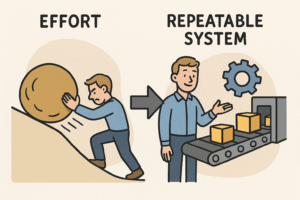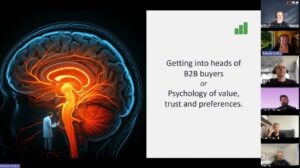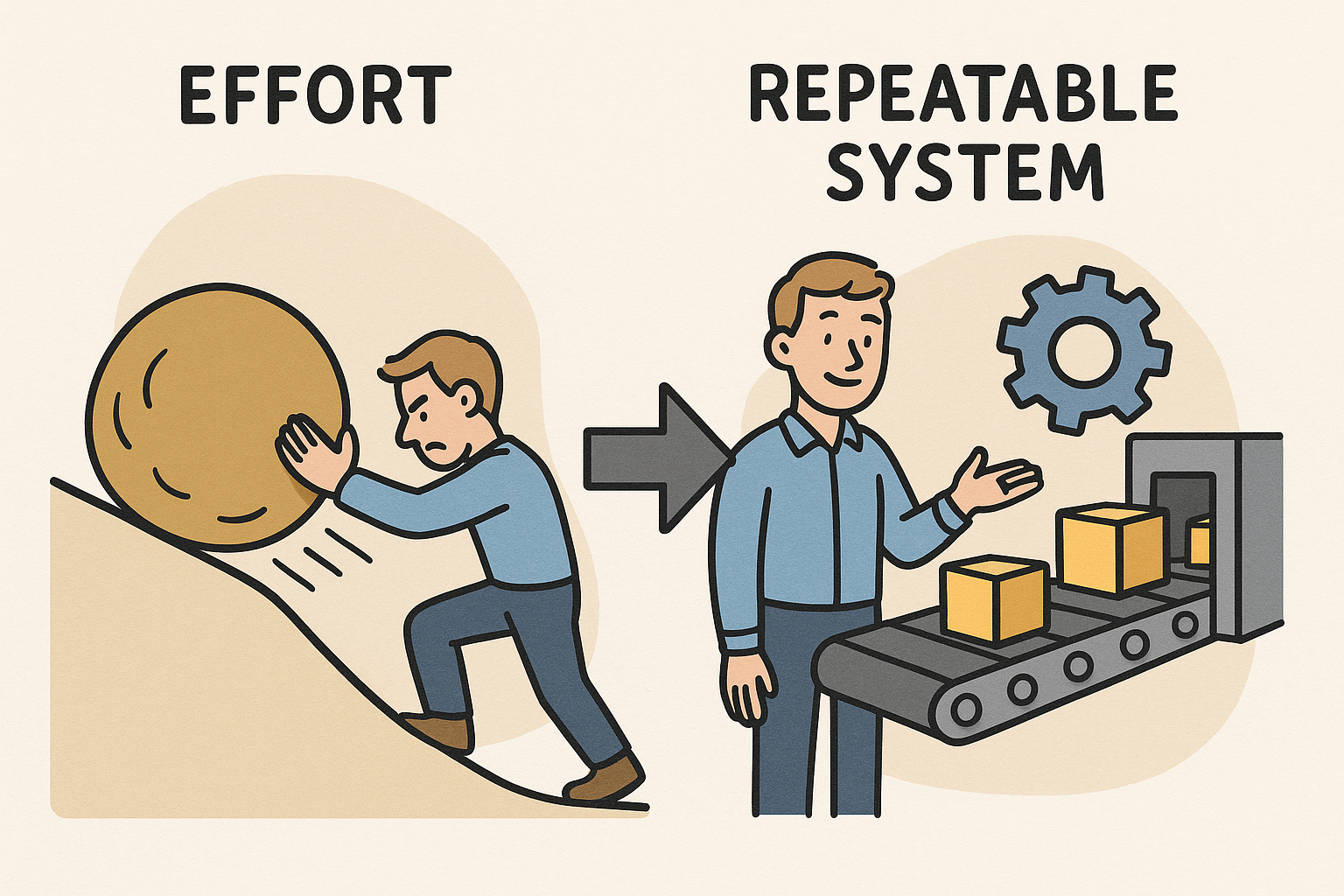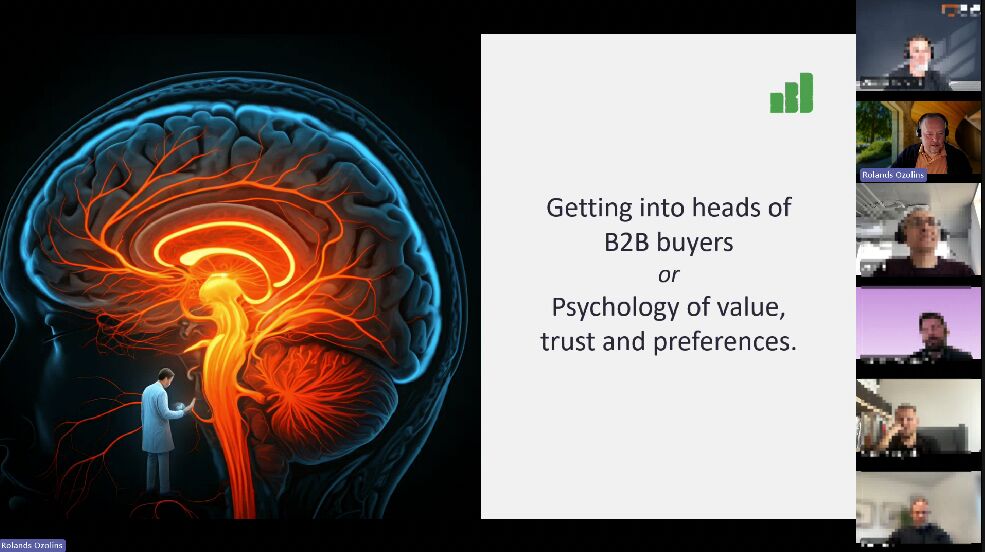This blog was edited and updated on 12.06.2023.
Today, given the ever-increasing choice of suppliers and limited attention spans of B2B buyers, the only way to thrive in international markets is to design marketing and sales processes around how customers buy.
This is called the buyer’s journey or customer journey, and it is an essential element of modern marketing.
A well-planned customer journey will allow you to grow your marketing and sales pipeline. You will generate more leads with a smaller team and optimize your marketing spend at every stage of the buyer’s journey.
It will also help you properly allocate resources, such as pre-sales engineer time, when planning business growth.
Let’s start with a brief overview of how the B2B buyers of today make their purchases.
How do B2B customers make their purchases?
B2B buying behaviour has significantly changed in recent decades due to the increased availability of digital technologies. The most significant change to have taken place is that buyers now take much more ownership of the customer journey.

Before contacting a sales representative, they will already have consumed 3-7 units of marketing content. So the best thing a seller can do is to make buying journeys a path of least resistance. Make it truly easy for customers to find and consume information and gently guide them through the purchasing process.
A good illustration of how buying behaviour has changed is provided in the McKinsey study of the way passenger cars are purchased. Twenty years ago, buyers would make over six visits to dealerships before making a purchase. Today, the average is down to 1.6.
The same behaviour is reflected in B2B markets. Buyers want to be in control of the process and learn on their own, instead of being lectured to by sales reps.
In fact, most buyers only want to talk with sellers when they have already completed their research and developed supplier shortlists. Recent research by Hubspot Research indicates that 60% of buyers only want to talk with a salesperson when they already have made a shortlist.
Unless buyers were able to engage with your marketing content early in their customer journeys to research your solution, there is a slim chance you will get on the shortlist.
Because of this change, what happens before the customer contacts sales representatives have become critically important.
This is exactly the reason why planning your customers’ journey is essential for business success and why it is at the foundation of modern B2B marketing.
What is a B2B buyer’s journey?
“The buyer’s journey” is a marketing concept that looks at customers’ behaviour as they progress towards the purchase as a process made up of several steps.
One way to look at the buyer’s journey is to view it in terms of possible questions that buyers might have at various phases of the buyer’s journey.

Simple customer journey. Source: IBD Consulting
Early on in the buying journey, customers might need to be made aware that they have a problem. Later on, the customer will be looking to learn more about the problem and looking for ways to solve it. At this point a guide on how to solve the problem would come in handy.
The seller’s objective in this regard should be to come up with answers to all these questions and answer them via various types of marketing content.
Note that each phase has its own business goals and content types that are most likely to answer questions that customers might have at each stage.
Today, most product research activities take place online.
Modern marketing analytics allow for a precise understanding of customer behavior and conversion rates at each stage. As a result, it is possible (and indeed necessary) to optimize customer flow right from the first visit to the website. This presents unprecedented possibilities to increase the efficiency of the marketing and sales process, do more with a smaller team and outperform the competition.
Today, competition takes place between different buying journeys. If you create a path of least resistance for the buyer, you have the upper hand over the competition.
What if you do not plan buyers’ journeys?
If a company doesn’t plan buyers’ journey, it is very likely they miss the earlier steps that prospects take before they are ready to talk with your sales.
One of our clients had not planned any marketing activities for prospects that are not yet ready for demo or trial.
While they got some incoming web traffic, we noticed that much of the traffic lands on the pricing page. This indicates that visitors’ intent was only to get pricing information about their product.
Why would they do so?
We believe they had already made up their mind about the competing solution, however, they were required to compare the selected solution with alternatives. Hence all they came for was to get pricing details to enter into the comparison table to formally justify the purchase decision they had already made.
We helped customer to create content that helped to engage prospects earlier in their buyers’ journeys.
Moving customers forward
The purpose of each stage of the buying journey is to prepare and gently drive customers on to the next stage.
To move customers ahead in their buying journey, compelling marketing content is developed, including white papers, infographics, product videos webinars, etc. The most valuable content, such as white papers, webinars or economic justification tools, are exchanged for customer contact information.
After customers’ contacts have been obtained, marketing automation comes into play. Customers will start receiving automated flows of marketing content designed to increase customer understanding of the product and develop buying intent.
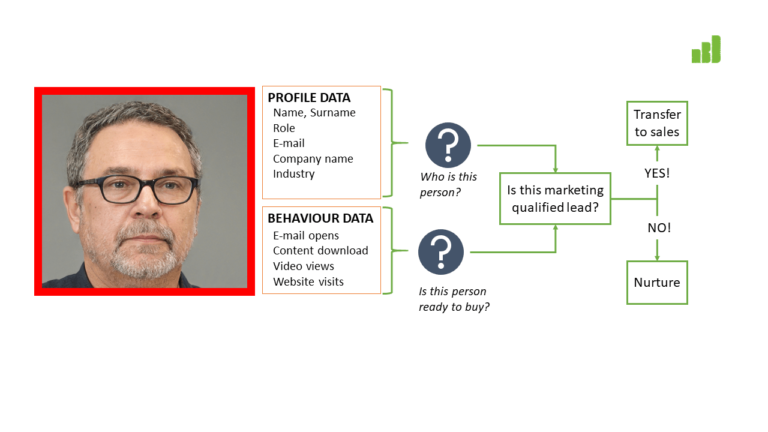
Once marketing analytics indicate that customers have been sufficiently educated about the product and are demonstrating a high level of interest, it is considered that a marketing qualified lead has been generated and customer details are handed over to sales team to initiate a sales conversation.
In this way it is possible, to a considerable extent, to automate b2b lead generation and focus the efforts of the sales team on customers who are already ready to buy.

This process and marketing automation technology thus enables even a small marketing and sales team to work at very high level of productivity.
Going from product features to risks
Early in their customer journey, customers are most concerned about better understanding their problems and they are interested in the features of possible solutions.
This is the best time to engage and educate buyers because they are most open to new information.
They might have found your solution specifically because of the innovative features of your product.
Later in the customer journey, customers are more concerned with risk; therefore, it is essential to ensure you cover areas of potential customer concern in your communication.
In a LinkedIn study, trust in relationships came up as the most important factor when deciding about purchases (this was also found in a number of other studies of B2B customers). Reliability was followed by financial considerations (ROI) and the price came only third.
When thinking about your buyer’s journey, it is very important to ensure that things such as warranties, quality procedures, customer support policy and returns (if relevant) are explicitly described and available to customers.
It will also help if company management and sales representatives have a professional online presence, particularly on LinkedIn.
When planning your buyers’ journeys it’s a good practice to consider FUD as your key competitor.
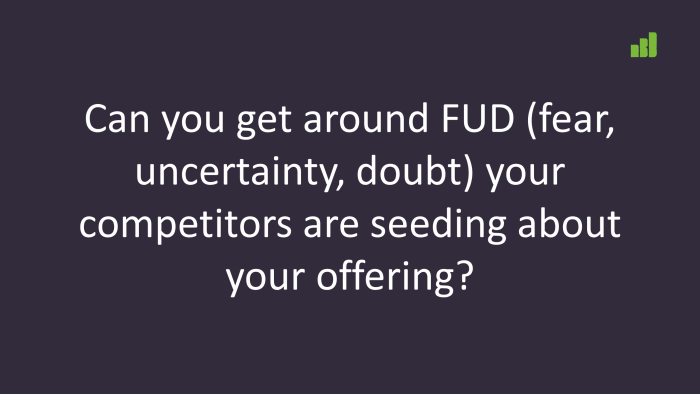
What is FUD and why should you care?
FUD is fear, uncertainty and doubt that your customers are likely to feel about your solution.
Moreover – FUD is something your competitors will try to seed in your buyers’ minds about you.
FUD is why your competitors with inferior and more expensive products win, FUD is also the reason why customers sometimes do not make a planned purchase at all.
Nobody wants to be blamed for spending money on an unreliable products.
If you have a substantial number of customers excited about your product features but very few actual buyers, it may indicate that there are FUD issues, whether justified or not, with what you are offering.
Staying upmost in customer’s mind
In B2B solutions sales, sales cycles are frequently measured in months and it is not uncommon for them to last over a year. Moreover, while buyers might indeed have a need, it is likely that the time is not right to make a purchase.
Also, it is likely that while preparing to make a purchase decision, customers will consider more than one supplier.
Under these conditions, it is important to always remain upmost in the customer’s mind.
How can you do this?
A good way to keep existing and potential customers informed is to issue a company newsletter.
But at some phases of the buying journey, it is necessary to do more than this; a good example is sending a weekly e-mail with tips for product use during the exploration phase. Or case studies when buyers are considering your product.
Sending information frequently serves an important psychological purpose. People tend to value as more important information they received recently and the information they receive regularly. This develops a positive attitude towards the sending entity. Social psychologists call it recency bias and mere exposure effect.
Making the customer successful
In most industries, the customer can’t fully experience and evaluate the product before making a purchase. In the software market – and particularly the Software-as-a-service market – you want customers to have used your product well before they make the payment.
For this industry, the trial period is critically important to make sure customer is getting the experience they want; therefore, investing in different customer success activities makes total sense, starting from interactive starting guides, to onboarding e-mail sequences, to chatbots, to dedicated customer success manager.
If the customer has gone as far as starting the trial, the significant amount spent on marketing to acquire the customer has already been worth it.
At the same time, they are quite likely to be worth tens or perhaps a hundred times more in terms of expected customer lifetime value – if they actually become a paying customer, that is.
Because of the recurring business nature of SaaS, it is necessary to consider buyers’ journeys as a continuous process. You need to prove your product’s worth all the time, and you should be ready to re-engage in the marketing and sales process to the existing customers all the time.
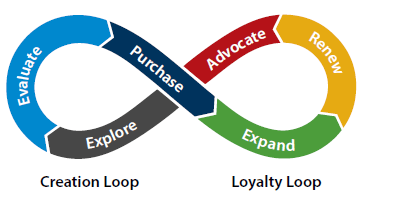
No customer will start paying after the trial period unless they can get a good return for their money, so carefully calculate how much you want to invest in customer success. Chances are, it’s worth investing much more than you think.
Bringing customers back to the buyer’s journey
There is inevitably customer churn during the buying journey.
In fact, on average as few as 2-4% of visitors to a website take any of the actions that the seller desires them to. In B2B business it is not unusual that even less than one per cent take any action, such as registration for content or contacting the seller.
Not all of this churn is necessarily bad. If customers discover early on that your solution cannot meet their needs – that’s great! You will not use up your precious energy only to discover after a number of sales calls that the solution doesn’t fit their needs.
While some customer churn is expected, it is well worth identifying customers that haven’t returned to your website in a while or haven’t been reading your e-mails.
Remarketing is a good, and highly cost-efficient way to do exactly that. Have you ever noticed that banners from recently visited website follow you even when you’re on a completely unrelated sites? These are examples of remarketing.
While remarketing returns only a small fraction of lost customers to the buyer’s journey, because you are only paying for actual clicks, it is in fact an extremely efficient way indeed to re-engage potential customers.
Customers are not all the same – and neither are customer journeys.
To make your buyer’s journey as efficient as possible, you need to design it around your buyers’ specific personalities.
It is quite common to designate marketing content as targeted to business decision-makers or technical decision-makers; however, this alone is not enough to maximise sales opportunities.
To maximise the efficiency of your buyer’s journeys, it needs to be designed with very specific buyers personas in mind. One should consider customers’ demographics, interests, values, objectives, role in their organisation and other factors for each type of buyer’s persona that participates in the buying decision.
A simple buyer persona example is shown below.
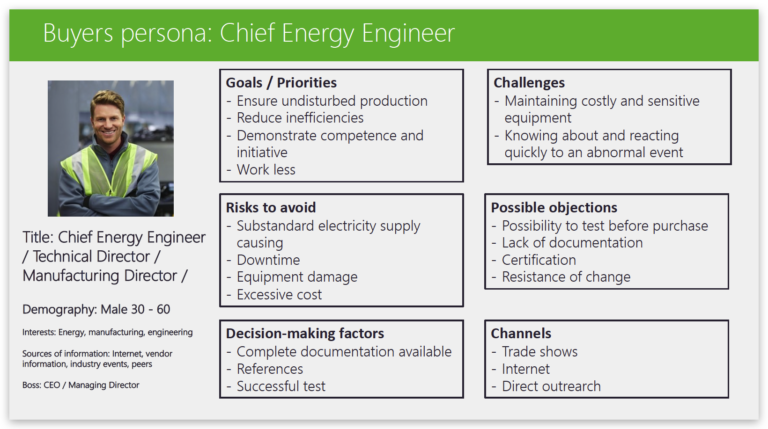
Dramatically increase sales efficiency
While a well-planned buyer’s journey creates an easy way for customers to progress toward buying decisions, it also significantly improves customers’ understanding of the solution. Videos of the solution, how-to guides, webinars and other marketing content educate potential customers. This means that when customers are ready to contact a sales representative, most of their product questions have been answered already.
As a result, salespeople do not need to spend precious 1-to-1 time in educating customers or answering simple questions that could be easily answered with simple solutions videos or over a webinar.
Instead, salespeople can work with qualified and educated leads and make progress to closing the sale much faster.
What’s more, customers whose needs cannot be met by your solutions will discover this early on and on their own, which means that salespeople’s time will never be taken up only to discover later that for some reason the specific needs of the customer cannot be met.
The role of marketing and sales in the buyer’s journey
Traditionally, there has been a significant gap between marketing and sales functions in companies, and, for most established companies, closing this gap presents a considerable organizational challenge.
To succeed in implementing the inbound marketing principles, it is essential for marketing and sales teams to work together and have a shared understanding of the customer journey from start to finish.
The sales team needs to understand the marketing part of the journey and actively contribute to designing it, while the marketing team needs to have a good understanding of the B2B sales process and the needs of the sales team. Companies’ management should oversee this process at the executive level and adjust incentives to stimulate collaboration.
A good starting point is for both teams to agree on definitions and criteria of qualified leads. Once sales start receiving qualified leads, they will be much more open to collaborating and helping marketing to finetune its work.
Using external consultants
Perhaps the fastest and most efficient way to improve lead generation is to use an external consultant who can help with planning your buyer’s journey, developing marketing content, implementing marketing automation and running underlying marketing analytics while at the same time training the company’s personnel to understand and make the most of the buyer’s journey.
IBD Consulting is a management consultancy helping technology companies to increase sales in B2B markets. Contact us to discuss if and how we can help growing your business.

